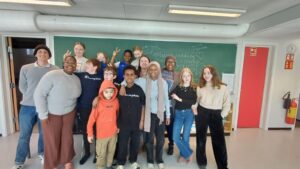Hello from Senja! We have had an amazing last full week of school filled with incredible experiences both in and out the classroom. As the experience comes to an end, we are all filled with bittersweet feelings as the excitement of returning home to our loved ones creeps up on us but also the sad realization that we are leaving this wonderful and beautiful country very soon.
There are many differences that we have noticed between South African and Norwegian schools in terms of classroom management practices and pedagogical focus. The main things that we have noticed in terms of classroom management practices here in Norway is that Norwegian schools seem to place a large emphasis on student autonomy and self-directed learning. This is very different to South African schools where the approaches are a lot more formal and structured. The Norwegian classroom also encourages and allows for more active student participation and discussion in the classroom as opposed to the more authoritative and teacher-centred approach to classroom management that the South African classroom and curriculum requires. Teachers here in Norway act more as facilitators of learning and coaches rather than the one-way lecture-based teaching which is commonplace in South African schools.
South African schools place a large emphasis on hierarchical structure with clear positions and a large respect for authority. Whereas here in Norway it is a lot more relaxed where students are able to call even the principal by their first names which is something that a South African learner would never even dream of doing. The students here in Norway also are a lot less disciplined, not in a negative way but they have a lot more autonomy. They are able to freely walk around or get up and go to the bathroom or get water whenever they want, which is something that is allowed in South Africa as well but generally only with the teachers’ permission. This may also be due to the much smaller class sizes here in Norway as it is a lot easier to keep track of 10 to 15 learners as opposed to 30 to 35.
When it comes to pedagogical focus there is a stark contrast between the Norwegian methods and the South African ones. In the Norwegian classroom there is a strong focus on student-centred learning and inquiry-based approaches. We personally tried these approaches in a lesson with the grade 5, 6, and 7 learners where we had to teach them a few things about South Africa that they had specifically requested, so we grouped them up, had each group pick a topic at random and then set up stands to present what they had learned to the other groups. The lesson was a great success, and it was great fun to see the learners so excited as they got complete control of what they wanted to learn and how they wanted to learn it.
The curriculum here allows for a lot more freedom on the behalf of both teachers and learners and emphasizes critical thinking, problem solving and collaboration. Their system also encourages interdisciplinary learning and project-based work. On one of the school days this week the teacher connected the same theme to the English, Norwegian and Social Studies lessons which really aids the students in drawing
connections across the curriculum. It also allows for concretization which gives students something to think back and draw upon when learning.
Assessments here in Norway are also more competency based and very different to the rigid structure of South African assessments. For example, in the mathematics exam that we witnessed the learners write, the focus was not on the answers to the questions, but the students are rather required to explain the processes and models that they learned and can use in their tests. The focus here is also a lot less focused and prescriptive as they are in South African schools. The learners have English classes, Norwegian language classes and then mathematics. Aside from that they have KRLE, which is a subject that focusses on religion, lifestyle, and ethics. They then also have social studies which seem to include geography, biology, and sciences.
South African schools have a much more subject-focused approach with a large emphasis on core subjects such as math, science, and languages. The assessments in South Africa are also more summative and exam based with a large emphasis placed on student performance and grades. Students are able to fail and be held back in schools in South Africa whereas here in Norway that does not seem to affect a learners schooling. In South Africa a student receives a percentage grade and if they do not get above 40%, they have failed, but here in Norway they receive grades from 2 to 6, 2 being low and 6 being excellent, and this does not affect their progression.
So far it has been an extremely interesting experience for us South African students to see how different the education system is here in Norway. There are a lot of useful tips and techniques that we have learned and hope to implement into our own teaching practice when we return to the classroom in South Africa!
